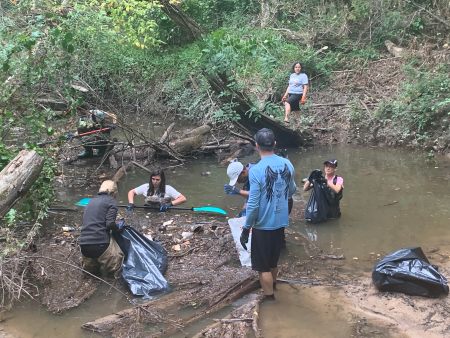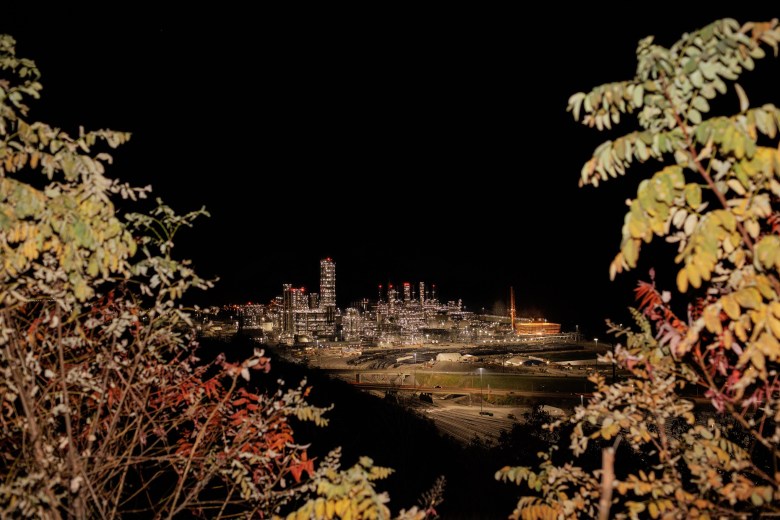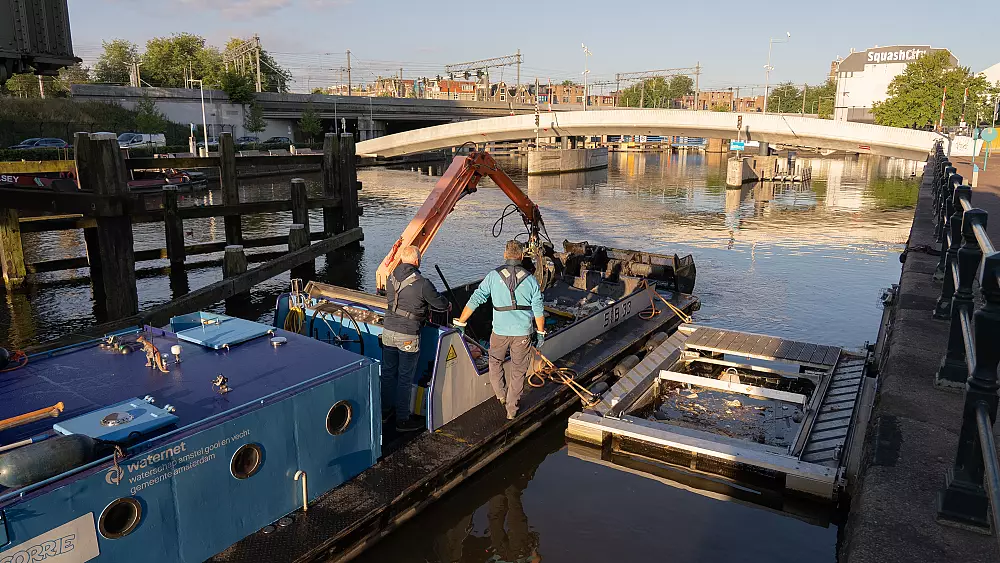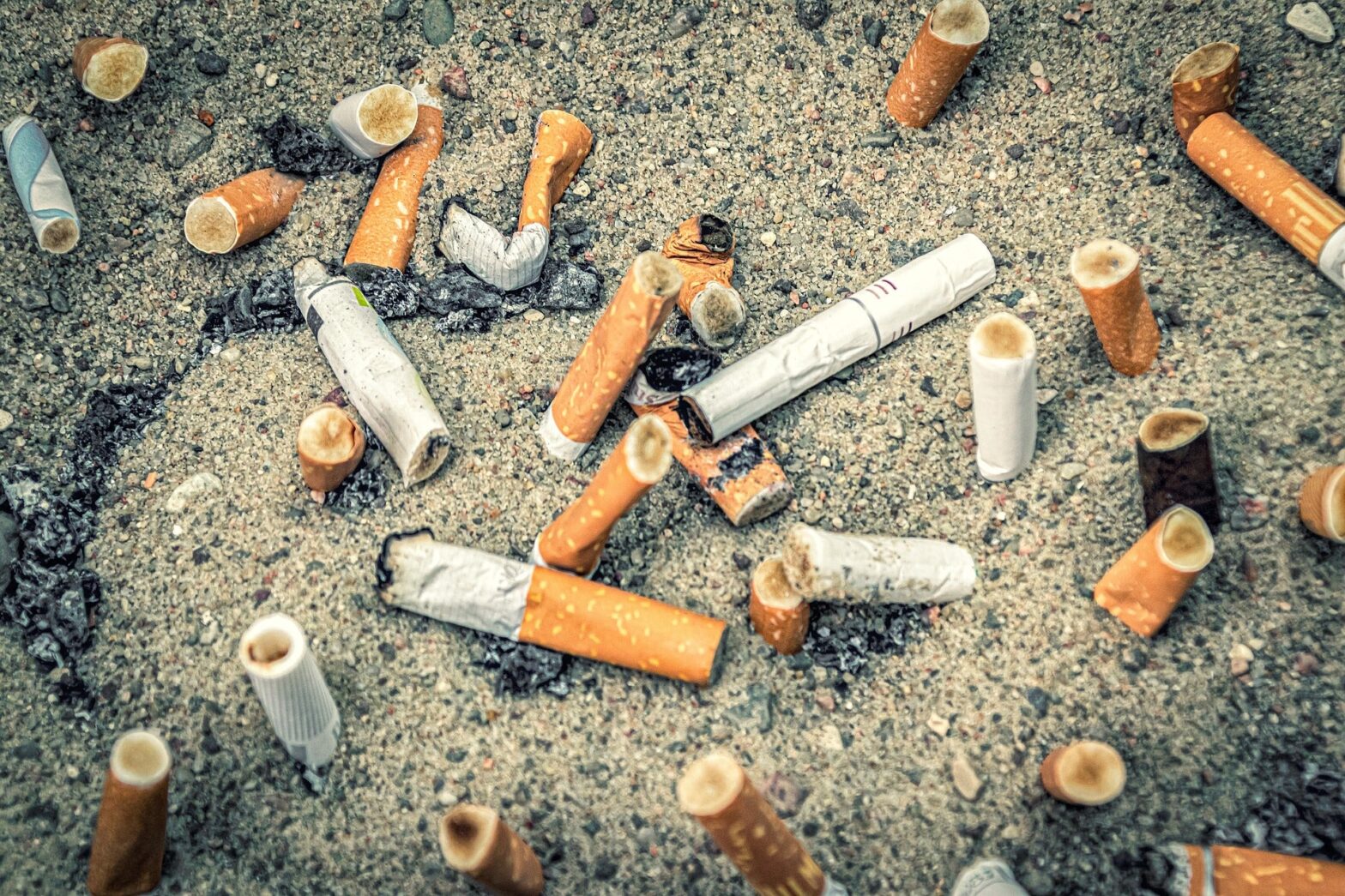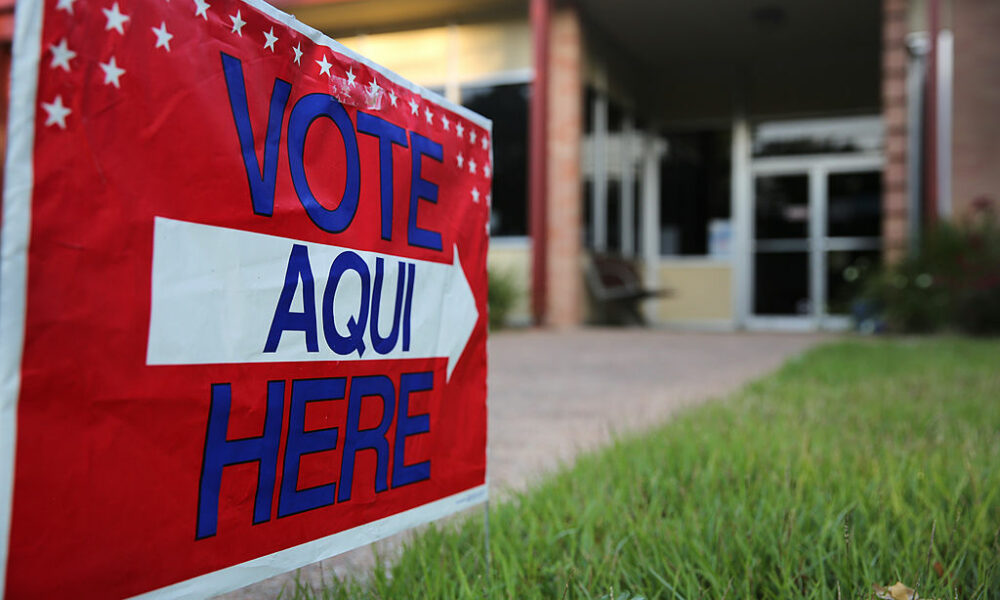By Will Atwater
On a cloudy Saturday morning this past September, Emily Sutton ventured out into Durham’s Third Fork Creek in her waders. Standing in the creek’s waist-high murky water, Sutton, using a canoe paddle, began pushing plastic waste and other litter toward volunteers who, also in the water, placed the debris into trash bags.
Since January, Sutton, the Haw River riverkeeper, and other riverkeepers across the state have been conducting bi-weekly cleanups in urban waterways. Sutton said this effort is funded through an environmental enhancement grant and is administered through the North Carolina Department of Justice, which, she said, provided one trash-catching trap for each of the state’s 15 watersheds.
“All 15 of us will take samples upstream and downstream of one watershed, and most of us are looking at an urban watershed,” she said.”We can get upstream samples from a location that’s not so heavily impacted by the urban development, and then the same creek downstream, we’ll get microplastic samples, so we can really understand what the loading is from an urban area.”
Meanwhile, Nancy Lauer, staff scientist with the Duke Environmental Law and Policy Clinic, was standing on the bank, sorting the waste particles Sutton and the volunteers pulled from the water.
“You can’t go to an urban stream and find a clean stream,” Lauer said. “It’s pretty remarkable.”
Plastics began being mass produced in the 1950s. Since that time, the material has become a fixture in everyday life — it’s in the clothes we wear, the cars we drive, the food and beverage and prescription drug containers we bring home, as well as the communication and entertainment devices we use, among other things.
“More than 70 years of innovation and this exceptional class of materials has brought really unprecedented societal advancement … We simply cannot live without plastics in the year 2022,” said Kara Lavender Law, research professor of oceanography with the Sea Education Association. “However, as we all know, this has come at a cost, and that’s a concept we’re only now beginning seriously to address.”
There will likely be multiple ways to address those costs. One recent insight comes from looking at chemical recycling using bioengineered organisms to break plastic compounds down to their original components. Researchers say that could provide a road map for how to address the mixed-use plastic recycling issue, which each year leads to millions of metric tons of plastic waste in landfills instead of recycling centers.
It’s raining plastic
Law made her comments about the costs of plastics as the keynote speaker during a recent webinar called “A Global Look at Plastic in the Ocean.”
Currently, the U.S. does not have a recycling system robust enough to deal with a constant stream of single-use plastics, commonly used to package consumer and household items such as bottled water, liquid detergents, perishable foods and countless other items.
Plastic waste not properly recycled often ends up in landfills and waterways, and ultimately in the ocean. Annually, 8 billion metric tons of plastic waste reaches the ocean By the time that waste reaches the open water it is often degraded and worn down into microplastics, particles about 5 millimeters, smaller than a pea.
Those microplastics are consumed by marine life. They’re not the only ones: researchers have found that, on average, humans consume roughly 5 grams, or about a credit-card size amount of microplastics each week.
According to a study published in 2021 by the National Institutes of Health (NIH), currently, there are no direct links between plastic/microplastic ingestion by humans and specific negative health outcomes. But some studies “suggest that effects of microplastics could include provoking immune and stress responses and inducing reproductive and developmental toxicity.”
In 2019, U.S. plastic production equaled more than 121 billion pounds, according to data provided by Statista, a consulting firm that compiles consumer and marketing data. Seventy years of plastic production and consumer consumption has generated hundreds of millions of tons of plastic waste over the years.
The U.S. contributed between a half million to 1.5 million tons of plastic waste to the coastal environment in 2016, according to Law. In the same year, the U.S. generated more plastic waste than any other country (42 million metric tons). Between 2.33 and 2.99 percent of plastic waste produced was “mismanaged,” which could mean that it was littered, illegally dumped or not recycled properly.
In the U.S., plastic currently accounts for roughly 12 percent of municipal solid waste. What’s more, only 5 percent of U.S. plastic waste was recycled in 2021.
Tracking plastic waste in NC waterways
Since 2021, North Carolina waterkeepers and environmental organizations have been documenting the amount, type and size of plastic debris that they remove from waterways across the state.
Lauer partnered with Sutton to document debris removed from Durham’s Third Fork Creek. According to Lauer, from June to September 2022, 6,533 pieces of waste were collected. Eighty-five percent of the waste was Styrofoam, plastic bottles accounted for 5 percent, and the remaining 10 percent was a mixture of items such as food wrappers, plastic lids and caps, cigarette butts, and glass bottles.
From November 2021 until September 2022, Asheville GreenWorks, a Buncombe County-based environmental organization that works with communities to create a “community-led” response to environmental issues, removed more than 10,000 pounds of debris (much of it plastic and microplastic waste) from eight creeks across Buncombe, Henderson and Madison counties, according to Eric Bradford, director of operations.
Cape Fear River Watch (CFRW) and the Haw River Assembly are two Waterkeepers Carolina organizations that have installed trash “trouts’ — devices made of metal fencing anchored to the bank that trap debris floating on the water. They’ve put them in selected waterways and documented the debris collected during volunteer cleanup events.
Rob Clark, CFRW’s water quality program director, reported data from three trash collection dates between mid-August and mid-September 2022: 537 items were collected — 99 percent was plastic waste, Styrofoam made up 76 percent of the debris.
The three organizations’ combined totals equaled more than 17,000 pounds of solid waste. Plastic waste accounted for the majority of materials, with Styrofoam representing the most commonly found plastic waste material.
Solving the mixed-use plastic issue
Many environmentalists and research scientists argue that the only way to address the spiraling plastic waste problem is by enacting policies that force manufacturers to halt or at least require that all single-use plastic manufacturing must be recyclable.
In an email, Lauer noted in previous “urban stream” cleanups that did not involve trash trouts, “We found a lot more plastic bags, food wrappers, glass bottles, broken glass pieces and metal drink cans … ” She added, “What I’m observing is that those items tend to fill up with sediment and/or get snagged on the banks. So that stuff is all ending up in urban streams too, but it’s not flowing downstream as effectively as Styrofoam and plastic bottles do.”
Currently, much of the plastic material that finds its way into your home is not recyclable, and the pieces that are recycled are often mixed together, which requires sorting when the materials reach the recycling facility. Sorting can be a costly process for the business to separate plastics “by resin type.” As a result, this may not happen, which means plastic materials end up in the landfill, subverting recyclers’ good intentions.
But according to a recent study, there may be a process by which all single-use plastics, regardless of resin type — even sediment-laden plastic containers retrieved from waterways — could be recycled and reduced down to the basic building blocks of plastic and reformed into a viable container. This process would, in theory, reduce the cost associated with separating mixed plastics by the recycler and make recycling more financially lucrative, the researchers say.
The chemical recycling process could also reduce the amount of virgin plastic needed to be produced each year as well as address the problem of what to do about Styrofoam and glass and plastic bottles that, like the ones pulled from Third Fork, have to be thrown away because they are too dirty to be recycled.
“If you’ve been participating in these river cleanups or whatever, you’ll see some plastics that may be really brittle after a while, or yellowed, or something,” Sullivan said. “It’s reacting with oxygen in the environment and that usually takes a really, really long time to happen, but eventually, it will break down.”
“What we’re really doing with this process is accelerating that reaction with oxygen, and we use that when we use the metal catalysts that are described in the paper. And they essentially just facilitate the reaction of the oxygen with the plastic to make it break down much, much faster. You know, instead of taking hundreds of years, it takes a couple hours … That’s the general idea.”
Werner draws a distinction between their approach and other forms of chemical recycling which, she says, involves transforming an existing product into a recycled one of lesser value.
“We’re actually taking the waste mixed plastics, and creating something of a higher value,” she said. “And so that’s why we call it upcycling because we’ve taken the plastics to their molecular building blocks, we can build them back up into something of higher value.
Sign up for our Newsletter
This form of chemical recycling involves pairing the oxidation process with bioengineered organisms, which helps complete the task of reducing plastic polymers back down to a monomer (its basic form) so that it can be upcycled into a high-value product.
‘Treating the symptom, not the cause’
Many environmentalists push back on chemical recycling as a potentially expensive approach to dealing with plastic waste, which takes the responsibility off the manufacturers, who, they say, should be required to solve the problem that they created. Some are also concerned that the use of bioengineered organisms could pose an environmental risk if they were to escape the lab setting.
“I think that chemical recycling is treating the symptom and not the problem,” Sutton said. “With any pollution issue, we really want to get to the source. So it’s not downstream, even hypothetically, or figuratively [speaking]. In this situation there’s always the source who really should be responsible for limiting [plastic waste], not these new industry chemical manufacturing facilities.”
Not to mention that plastics manufacturers have an economic disincentive to reduce the amount of materials they produce.
While University of North Carolina Department of Chemistry professor Frank Leibfarth, understands how environmentalists feel about the plastic waste issue, he sees value in a multi-angled approach to addressing the problem.
“Plastic waste is a gigantic issue. We make enough plastic to fill a modern football stadium every day,” he said. “Making this more sustainable will require using every tool at our disposal. Plastic manufacturers should do their part … and hopefully we can get policies to enable that.”
Leibfarth said putting more policies in place won’t solve the entire problem though.
“We need new innovations in materials, recycling technology, and sorting technology on top of policy change,” he said.
Law believes we need an all-of-the-above approach to addressing the plastic waste problem. She believes the answer involves “making, using and consuming” fewer plastics, which can be achieved through “education, behavior change, new product delivery systems and legislation.”
Republish This Story

